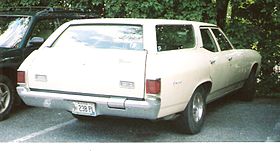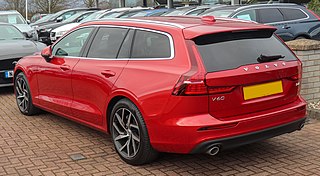
A station wagon or estate car is an automotive body-style variant of a sedan with its roof extended rearward over a shared passenger/cargo volume with access at the back via a third or fifth door, instead of a trunk/boot lid. The body style transforms a standard three-box design into a two-box design—to include an A, B, and C-pillar, as well as a D-pillar. Station wagons can flexibly reconfigure their interior volume via fold-down rear seats to prioritize either passenger or cargo volume.

The Chevrolet Chevelle is a mid-sized automobile that was produced by Chevrolet in three generations for the 1964 through 1977 model years. Part of the General Motors (GM) A-body platform, the Chevelle was one of Chevrolet's most successful nameplates. Body styles included coupes, sedans, convertibles, and station wagons. The "Super Sport" versions were produced through the 1973 model year and Lagunas from 1973 through to 1976.

The Chevrolet Corvair is a rear-engined, air-cooled compact car manufactured and marketed by Chevrolet over two generations between 1960 and 1969. A response to the Volkswagen Beetle, it was offered in 4-door sedan, 2-door coupe, convertible, 4-door station wagon, passenger van, commercial van, and pickup truck body styles in its first generation (1960–1964), and as a 2-door coupe, convertible or 4-door hardtop in its second (1965–1969). Total production was approximately 1.8 million vehicles from 1960 until 1969.

The Volkswagen Transporter, initially the Type 2, is a range of light commercial vehicles, built as vans, pickups, and cab-and-chassis variants, introduced in 1950 by the German automaker Volkswagen as their second mass-production light motor vehicle series, and inspired by an idea and request from then-Netherlands-VW-importer Ben Pon.

The Chevrolet El Camino is a coupé utility vehicle that was produced by Chevrolet between 1959–1960 and 1964–1987. Unlike a standard pickup truck, the El Camino was adapted from the standard two-door Chevrolet station wagon platform and integrated the cab and cargo bed into the body.
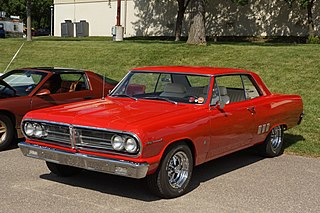
Acadian is a make of automobile produced by General Motors of Canada from 1962 to 1971. The Acadian was introduced so Canadian Pontiac-Buick dealers would have a compact model to sell, since the Pontiac Tempest was unavailable in Canada. Plans originally called for the Acadian to be based on the Chevrolet Corvair, which was produced at GM's Oshawa plant; however, the concept was moved to the Chevy II platform to be introduced for 1962. The brand was also offered in Chile, with models built in Arica.
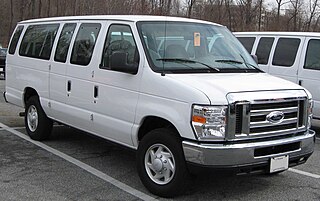
The Ford E-Series is a range of full-size vans manufactured and marketed by the Ford Motor Company. Introduced for 1961 as the replacement of the Ford F-Series panel van, four generations of the model line have been produced. Marketed for both cargo and passenger transport configurations, the E-Series has been designed with multiple design variations for both retail and commercial sale, including vans, and commercial-grade cutaway van chassis and stripped chassis.

The Chevrolet Suburban is a series of SUVs built by Chevrolet since the 1935 model year. The longest-used automobile nameplate in the world, the Chevrolet Suburban is currently in its twelfth generation, introduced for 2021. Beginning life as one of the first metal-bodied station wagons, the Suburban is the progenitor of the modern full-size SUV, combining a wagon-style body with the chassis and powertrain of a pickup truck. Alongside its Advance Design, Task Force, and C/K predecessors, the Chevrolet Silverado currently shares chassis and mechanical commonality with the Suburban and other trucks.

The Chevrolet Express is a series of full-size vans produced by General Motors since 1996. The successor to the Chevrolet G-series van, the Express is produced in passenger and cargo variants. Alongside the standard van body, the line is offered as a cutaway van chassis, which is a chassis cab variant developed for commercial-grade applications, including ambulances, buses, motorhomes, and small trucks.

The Chevrolet Malibu is a mid-size car that was manufactured and marketed by Chevrolet from 1964 to 1983 and from 1997 to present. The Malibu began as a trim-level of the Chevrolet Chevelle, becoming its own model line in 1978. Originally a rear-wheel drive intermediate, GM revived the Malibu nameplate as a front-wheel-drive car in 1997.

The Chevrolet Chevy II/Nova is a small automobile manufactured by Chevrolet, and produced in five generations for the 1962 through 1979, and 1985 through 1988 model years. Built on the X-body platform, the Nova was the top selling model in the Chevy II lineup through 1968. The Chevy II nameplate was dropped after 1968, with Nova becoming the nameplate for all of the 1969 through 1979 models. It was replaced by the 1980 Chevrolet Citation introduced in the spring of 1979. The Nova nameplate returned in 1985, produced through 1988 as a S-car based, NUMMI manufactured, subcompact based on the front wheel drive, Japan home-based Toyota Sprinter.

The Chevrolet HHR is a retro-styled, high-roofed, five-door, five-passenger, front-wheel drive wagon designed by Bryan Nesbitt and launched by the American automaker Chevrolet at the 2005 Los Angeles Auto Show as a 2006 model.

The GMC Sprint is a coupe utility/pickup that was produced by GMC for the 1971–1977 model years. The Sprint was renamed Caballero for the 1978 model year, and produced through 1987. The rear-wheel-drive car-based pickups were sold by GMC Truck dealers primarily in the United States and Canada as the GMC version of the Chevrolet El Camino. Trim designations, emblems, and wheel trim differentiate the GMC from the Chevrolet. The vehicles were built on the General Motors A platform through 1981; for 1982, it was re-designated the G platform as the A platform switched to front-wheel drive.

Chevrolet Nomad is a nameplate used by Chevrolet in North America from the 1950s to the 1970s, applied largely to station wagons. Three different Nomads were produced as a distinct model line, with Chevrolet subsequently using the name as a trim package.

The Buick Sport Wagon was a mid-size station wagon built by Buick and was shared with the Oldsmobile Vista Cruiser, Pontiac Tempest Safari and Chevrolet Chevelle Greenbrier. Featuring a raised roof and skylights over the cargo and second seat area, this model was an extended wheelbase version of the Buick Skylark station wagon. Buick Sport Wagons were built in three generations, spanning 1964–67, 1968–69, and 1970–72. During this time period, this was the only luxury level station wagon offered under the Buick model line until 1970 when the Buick Estate Wagon was returned as a full-size station wagon.
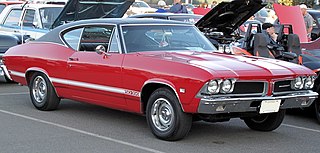
Beaumont was a make of mid-sized automobiles produced by General Motors of Canada from 1964 to 1969. These cars were based on the Chevrolet Chevelle, but the line had its own logo and nameplate, and was neither marketed nor actively sold in the United States. Its logo consisted of an arrow, similar to that of Pontiac, but with a maple leaf to signify its dual heritage from both sides of Lake Ontario.

The Chevrolet Lakewood is a four-door station wagon produced by Chevrolet for the 1961 model year. Chevrolet dropped the "x-wood" names for their station wagon models at the end of 1961 so the 1962 Corvair Station wagons do not continue the Lakewood name. In appearance, and technical respects it resembled the Volkswagen Type 3 Squareback, but power came from the Corvair's rear-mounted Chevrolet Turbo-Air 6 engine with 145 cu.in. displacement which developed 80 bhp (60 kW) at 4,400 rpm. The station wagon Corvairs were built on the same unibody as other sedan Corvairs with a 108 in. wheelbase. Standard transmission was a 3-speed manually shifted transaxle.

The Chevrolet Impala (fourth generation) is a full-size automobile produced by Chevrolet for the 1965 through 1970 model years. The 1965 Impala was all new, while the 1967 and 1969 models featured new bodies on the same redesigned perimeter frame introduced on the 1965 models. All Impalas of this generation received annual facelifts as well, distinguishing each model year. Throughout the early 1960s, Chevrolet's basic body designs became increasingly subtle, while the bright trim that was part of the Impala package added more than a touch of luxury to the look. The same pattern was followed in the interiors, where the best materials and equipment Chevrolet had to offer were displayed. In short, the Impala was on its way to becoming a kind of junior-grade Cadillac, which, for both the company and its customers, was just fine.

The Chevrolet Van or Chevy Van is a range of vans that was manufactured by General Motors from the 1964 to 1996 model years. Introduced as the successor for the rear-engine Corvair Corvan/Greenbrier, the model line also replaced the panel van configuration of the Chevrolet Suburban. The vehicle was sold both in passenger van and cargo van configurations as well as a cutaway van chassis that served as the basis for a variety of custom applications.

The first-generation Chrysler minivans are a series of minivans produced and marketed by the Chrysler Corporation from the 1984 to the 1990 model years. Introduced as the first minivans from an American-brand manufacturer and popularizing the minivan as a vehicle, the Dodge Caravan and Plymouth Voyager were launched ahead of chief competitors Chevrolet Astro/GMC Safari and Ford Aerostar.




